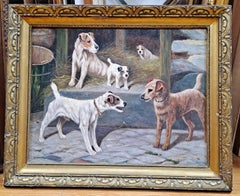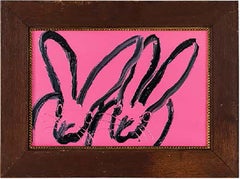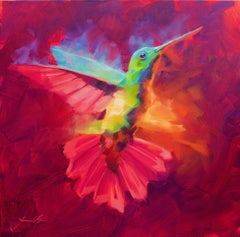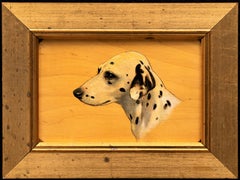Frances (Florence) Mabel Hollams Art
to
1
1
F. M. Hollams (1877-1963) Jack Russells in a Barn Oil on Canvas Board Painting
By Frances (Florence) Mabel Hollams
Located in San Francisco, CA
F. M. Hollams (1877-1963) Jack Russells in a Barn Oil on Canvas Board Painting
24" x 18.5"H
24" x 28"H
Category
21st Century and Contemporary Frances (Florence) Mabel Hollams Art
Materials
Oil
Related Items
Pink Couple
By Hunt Slonem
Located in Washington Depot,, CT
A wonderful, vibrant bunny portrait with two bunnies outlined in black on a bright pink background in a beautiful old wooden frame, with gold detail.
Category
2010s Neo-Expressionist Frances (Florence) Mabel Hollams Art
Materials
Wood, Oil
Humming Bird II
By Jamel Akib
Located in Battle, East Sussex
Jamel Akib
Born in Leigh-on-sea, Essex in 1965 to English and Malaysian parents, Jamel moved to North Borneo at the age of five. At thirteen he returned to England to pursue his edu...
Category
21st Century and Contemporary Contemporary Frances (Florence) Mabel Hollams Art
Materials
Canvas, Oil
Small Humming Bird- Purple - Oil painting by English Artist Jamel Akib
By Jamel Akib
Located in Battle, East Sussex
Jamel Akib
Born in Leigh-on-sea, Essex in 1965 to English and Malaysian parents, Jamel moved to North Borneo at the age of five. At thirteen he returned to England to pursue his edu...
Category
21st Century and Contemporary Contemporary Frances (Florence) Mabel Hollams Art
Materials
Canvas, Oil
20thC Modernist oil ' Dog in the Midday Sun' circa 1980
Located in Frome, Somerset
A fine 20th Century Modernist figurative oil painted by Christian Pedersen Bellinge (1897-1984)
oil on canvas 60cm x 70cm
painted wooden frame 68cmx 78cm
A good late work by the well...
Category
1980s Post-Impressionist Frances (Florence) Mabel Hollams Art
Materials
Oil
Free Shipping
H 26.78 in W 30.71 in D 2.37 in
Humming Bird No.2- Pink - Oil painting by English Artist Jamel Akib
By Jamel Akib
Located in Battle, East Sussex
Jamel Akib
Born in Leigh-on-sea, Essex in 1965 to English and Malaysian parents, Jamel moved to North Borneo at the age of five. At thirteen he returned to England to pursue his edu...
Category
21st Century and Contemporary Contemporary Frances (Florence) Mabel Hollams Art
Materials
Canvas, Oil
Portrait of Julien Prieur as a hunter - Circle of Jean-Baptiste Oudry 1686-1755
By Jean-Baptiste Oudry
Located in PARIS, FR
This portrait depicts us the trusted confidant of the Conflans d'Armentières family. More precisely, Julien Prieur was the fiscal procurator of the Marquisate of Armentières, playing the role of representative of the "public ministry", safeguarding the interests of his lord. His role, one can imagine, was crucial at the death of Michel de Conflans (in 1717) since the latter left an heir, Louis, aged only 6, and a widow, Diane Gabrielle de Jussac, whom some memoirs describe as "a very clever grande dame" . Prieur ensured the smooth running of the family's affairs and it is probably to thank him for his services that Diane Gabrielle had his portrait painted, most probably by a painter close to Jean-Baptiste Oudry.
Julien Prieur appears as he is, middle-aged, with a benevolent look, in his hunting suit. Only his knotted wig links him to the nobility.
Above all, he is depicted as a hunter, a passion that he shared with the Marquis of Armentières. His very young master, Louis, became a first-rate hunter, hunting in the King's entourage, in whose cabinet he died of apoplexy in January 1774. As for the his son, he was one of Louis XVI's closest hunting companions, as numerous souvenirs attest .
1. Some biographical information about the model and the commissioner
While the identity of many 18th century portraits is uncertain, an old label stuck on the reverse of the canvas gives us some precise information on the identity of the model: "Mr. Julien Prieur, homme d’affaires de Mr. le Marquis d'Armentières - Commune of Brécy - Aisne". The label also suggests that it could be his son Louis Prieur living in Rocourt (probably Rocourt-Saint-Martin, a neighbouring municipality of Brécy), born on 30 September 1745, who died on 8 July 1826, but this hypothesis must be rejected in view of the model's clothing. This label probably gives us an indication on the previous owner the owner of this painting; we will see later why it seems likely that this label was affixed between 1826 and 1832.
Brécy is now a municipality in the Aisne County (Hauts-de-France) located between Soissons and Château-Thierry, slightly north of the Paris-Reims axis. It borders the municipalities of Armentières-sur-Ourcq and Rocourt-Saint-Martin. According to Louis Prieur's death certificate, he was in fact born in 1743 and not in 1745 . The age of the model in the painting and the dating of this painting would indicate that Julien Prieur, was probably born at the very end of the 17th century.
In Louise-Marthe de Conflans-Coigny, chatelaine de Brécy , we read that "the Conflans were a family of ancient nobility, which genealogists trace back to the 12th century, when it was said to have come from the house of Brienne. In the 16th and 17th centuries, this family had several illustrations in the profession of arms. [...] Michel de Conflans, [...] belonged to a younger branch of the family, of which Saint-Simon wrote, with his acid soaked pen, that "poor and obscure, they had never left their village, where their house resembled a hut" and elsewhere that they "lived on their rifles and cabbages".
Fortunately for Michel de Conflans, the last representative of the elder branch, Henriette d'Armentières, made him her heir on her death in 1712. It was through her that the land of Armentières and its 14th century castle became part of the estate of this branch, as well as, not far from there, the land of Brécy and the castle of Le Buisson, where the family lived. In the early years of the 18th century, Michel de Conflans was able to push himself into the entourage of the Duke of Orleans, becoming his first gentleman of the chamber. However it was above all his son Louis who restored the family status through his military career.
Born on 23 February 1711, Louis de Conflans, Marquis d'Armentières died of apoplexy on 18 January 1774, in the King's cabinet at Versailles. Appointed lieutenant general in 1746, he received his Marshal of France’s stick in 1768. The Dictionary of French Biography writes of him that "without ever achieving a high command, he appeared with honour in all the wars of his time".
The estates of Armentières and Le Buisson were sequestered during the French Revolution, declared national property and sold at auction (in 1794 and 1795 respectively) after the Marquise d'Armentières, the Marshal's second wife, was beheaded in 1794.
The Château du Buisson (where Michel de Conflans died in 1717) was bought by a granddaughter of the Marshal de Conflans, the Marquise de Coigny, in 1816 and remained in her family after her death in 1832 until the sale of the 1,054 hectares estate in 1866.
The bayonet blows that probably pierced the canvas in three places may well have a revolutionary origin and it is conceivable that the painting, acquired by the Marquise de Coigny from Louis Prieur, Julien's son, after the latter's death, was then restored and given the label specifying the name of the model.
2. Description of the portrait
The painting presents a man in his thirties in his hunting costume. Pictured at mid-body, his face is marked by his life in the open air and characterised by a look of great bonhomie. Holding a rifle under his elbow, he is soberly dressed in a large caramel-coloured jacket, decorated with silver buttons. Presented in a three-quarter view, the model holds a partridge in his right hand. The jacket opens onto a vermilion waistcoat. A green shoulder strap probably holds a powder flask hidden under his arm while a satchel is visible on his belt.
The model is wearing a grey wig, tied at the back with a black ribbon that seems to fly in the wind. This ornament anchors Julien Prieur in his time. "The new King of France, Louis XV, [imposed] a style of smaller wigs for men and the rigorous white or preferably greyish powdering. From the middle of the century men also used a ponytail on the back of the neck, tied with a ribbon, a style that became very popular in all courts."
He stands out against a dark, purplish sky at the end of an autumn day in a soberly sketched forest landscape. The treatment of the sky recalls the influence of Largillière, Oudry's first master.
3. Jean-Baptiste Oudry
Jean-Baptiste Oudry was born on 17 March 1686 in Paris, rue de la Ferronnerie. He began his apprenticeship around 1705-1707 with Nicolas de Largillière, with whom he stayed for five years.
In 1713 Oudry established his "livre de raison" in which he reproduced all his early works in wash drawings up until 1718. During this first period which lasted about 7 years, Oudry produced works of great diversity, both in the genres that the artist tackled and in the artists which influenced him. It has been estimated that he painted about 150 pictures during this period: mainly portraits, but also still lifes and some religious paintings and landscapes.
Of the hundred or so portraits that Oudry is said to have painted during this period, only fifteen have been identified today. A number of those lost portraits are probably still confused with works by Largillière.
First admitted to the Académie de Saint-Luc in 1708, he was then allowed to join the Académie Royale in 1717, and subsequently admitted as a history painter in 1719. This year marks a turning point from which Oudry will assert himself as an animal painter. In 1723 he met Louis Fagon, Intendant of Finances, and the Marquis de Beringhen, the King's first equerry, who became both friends and patrons of the artist, giving him access to royal commissions and enabling him to be appointed as painter of the Royal Tapestry Factory of Beauvais in 1726.
From 1728 onwards, the creation of tapestries became the core of his work, even though at the same time Oudry developed his skill as an illustrator, first for Scarron's Roman Comique and then for La Fontaine’s Fables.
Between 1726 and 1731, Oudry created the decoration of a large drawing room at the château de Condé-en-Brie, about twenty kilometres from Brécy, which has remained in place to this day. This important commission, about which few details are known, is said to have originated with the Countess de Verrüe, a great lady of the French Regency who often stayed at Condé with her friend Jean-François Leriget, Marquis de la Faye, then owner of Condé.
A prolific artist, Oudry fulfilled numerous commissions in parallel with his regular contributions to the Salons, to which he regularly took part until 1753. He suffered a stroke in 1754 and died the following year.
It seems almost certain, in view of the importance of his work, that Oudry supervised a workshop in which several artists were involved, but this point is very poorly documented. Given the geographical proximity of Brécy and Condé-en-Brie, the links between the Armentières family and the Condé patrons, and finally based upon the quality of our portrait, we propose the hypothesis that it was painted by one of the painters who worked with Oudry at Condé.
4. Related artworks: comparison with some other portraits of hunters by Jean-Baptiste Oudry
While Oudry gradually abandoned portraiture from 1720 onwards to devote himself to animal paintings, he seems to have made an exception for hunter portraits, which were often depicted in the company of their hunting dogs. Two examples seem particularly evocative and suggest a dating for our painting around 1730. We will see in a second part why this dating proposal seems relevant.
The first portrait worth mentioning is the presumed portrait of Lieutenant Claude-André Courtin de Crouey, lord of Quatre Fils and Cormeilles-en-Parisis made in 1723, reproduced below. Also presented in a very tight frame, it is interesting for the similarities in the representation of the rifle, and in particular the two metal rivets that are almost identical in our painting.
The painting that seems closest to ours is the presumed portrait of Monsieur...
Category
1730s Old Masters Frances (Florence) Mabel Hollams Art
Materials
Canvas, Oil
Contemporary, American, Blue, Vintage TV, with Cat in Mid Century Mod Room
Located in Fort Worth, TX
"Contemporary, American, Blue, Vintage TV, with Cat in Mid Century Mod Room" This work is titled, "Ten past 4:00." It is 41 x 58.25" and is Unframed Oil on Canvas. $18,000, price negotiable.
A well-known figure of the contemporary Fort Worth art scene, Daniel Blagg...
Category
2010s American Realist Frances (Florence) Mabel Hollams Art
Materials
Canvas, Oil, Acrylic
John Frederik Hulk II - Grazing Sheep
By John Frederik Hulk II
Located in Saint Augustine, FL
Artist: John Frederik Hulk II
Title: Grazing Sheep
Medium: Oil on Wood Panel
Dimensions: Unframed 13.5" x 13.5" Framed 19.5" x 16"
Frederik Hulk II paints a rural landscape. His careful brushstrokes create the fluffy, wool coats of the sheep as well as the detailed facial features in the foreground. These farm animals are dusted with bright and light. Behind them, Hulk’s forest provides a dark contrast as trunks and boughs crisscross and entangle. Hulk’s oil painting is both a playful and realist representation of 19th century Dutch landscape...
Category
Late 19th Century Realist Frances (Florence) Mabel Hollams Art
Materials
Oil, Panel
Impressionist:, School of Pierre Bonnard, signed oil 1950's
Located in Frome, Somerset
A fine large oil, school of Pierre Bonnard. circa 1950's.
oil on canvas 55cmx75cm
The original wood and textured gesso frame 72cmx92cm
Titled 'On the Window Sill'.
Indistinctly sign...
Category
1930s Impressionist Frances (Florence) Mabel Hollams Art
Materials
Oil
Free Shipping
H 28.35 in W 36.23 in D 2.37 in
Oil Painting, Small Shooting Scene By Chapman Bayley (British, Active 1818-1832)
Located in Uppingham, GB
Oil on canvas Shooting by the woods by Chapman Bayley (1818-1832)
Early 19th Century gent standing by the woods with his two dogs shooting.
Signed by the artist in original frame.
Ch...
Category
1820s English School Frances (Florence) Mabel Hollams Art
Materials
Oil
Summertime eagle
By FPA Francis Pavy Artist
Located in Lafayette, LA
This small work by Francis X Pavy measures 13" x 20".
About Francis X Pavy
In the vast tapestry of the art world, Art collectors are attracted to the enigmatic and mesmerizing w...
Category
2010s Modern Frances (Florence) Mabel Hollams Art
Materials
Oil
"Vase and Nest" oil on linen painting with vase and nest and butterflies
By David Kroll
Located in Phoenix, AZ
David Kroll
Vase and Nest, 2011
oil on linen
32" x 28"
Artist David Kroll is known for his finely crafted paintings—precise still lives and exquisite landscapes that allude to bot...
Category
2010s Contemporary Frances (Florence) Mabel Hollams Art
Materials
Linen, Oil
Previously Available Items
German Shepherd Painting Signed F.M Hollams, circa 1910 in Black and Gold Frame
By Frances (Florence) Mabel Hollams
Located in Atlanta, GA
An English oil on canvas dog painting signed H.M Hollams (1877–1963) depicting the bust of a German Shepherd in black and gold frame. Immerse your home in the timeless charm of this ...
Category
Early 20th Century English Frances (Florence) Mabel Hollams Art
Materials
Canvas, Wood, Paint
H 22.75 in W 18.75 in D 2.5 in
Dog Portrait of a Dalmatian by Frances Mabel Hollams circa 1930s
By Frances (Florence) Mabel Hollams
Located in SANTA FE, NM
Dog Portrait of a Dalmatian
Frances Mabel Hollams (England 1877-1963)
Circa 1930s
8 1/8 x 5 1/8 (11 7/8 x 9 frame) inches
Florence or Frances Mabel Hollams was a popular British painter of horses and dogs. She was active in the first three decades of the 20th century. She is noted for her unique technique of painting on wood panels, so the natural grain of the wood remains visible.
Mabel studied under the artist Franck Calderon, and at a time when most schools didn’t accept female students, she studied at the Academie Julian in Paris, which showed surprising initiative for a woman of the Victorian Age. By the age of 18 she exhibited at the Royal Academy showing a landscape which at this early stage of her career was her major subject and many of those went to collectors in America. She continued showing at the Royal Academy until 1912.
Early in her career she ceased painting compositions and turned her focus to portraying the simpler aspects of equestrian portraiture. Most of the influential sportsmen of the day became her patrons including the Duke of Norfolk, Earl Sefton, Earl Beatty, Lord Cornwallis, etc.
After looking at a horse for only five minutes and making a few sketches on pieces of wood in her paint box, she would herself take the wheel of her large car putting the chauffeur in the back (his duties incidentally had been to remove samples of the horse’s mane and coat for reference). Payment for commissions would be placed on a silver tray held by the butler in the entry hall.
Though never under any financial pressure, Hollams painted constantly and maintained a prodigious output.
Many of her most attractive portraits were from the canine field. Her portraits of favorite dogs and horses filled many country houses were hung with pride. A portrait of Her Majesty the Queen’s Aureole hangs at the top of the visitor’s staircase at Sandringham Castle.
Stella Walker comments in “British Sporting Art of the Twentieth Century” that Hollams 'had to compete with such outstanding exponents as Munnings and Lionel Edwards', but their respective styles were so different the comparison is hardly relevant. Hollams filled a need for lifelike reminders of treasured horses and dogs for customers who probably had little interest in art. The results have an almost iconic appeal and represent a way of life that changed forever after the first and second world wars, when the country piles, with stables full of horses, which she visited in her large car, started to decay and be sold off when their incumbents could no longer afford their upkeep. One of the best collections of work by Hollams can be seen at Calke Abbey in Derbyshire, the property of the National Trust.
British National Trust...
Category
Early 20th Century Realist Frances (Florence) Mabel Hollams Art
Materials
Wood Panel, Oil
H 11.88 in W 9 in D 0.75 in
"Johnathan" Cairn Terrier Dog Portrait by Frances Mabel Hollams (Eng.1877-1963)
By Frances (Florence) Mabel Hollams
Located in SANTA FE, NM
Cairn Terrier Portrait “Johnathan”
Frances Mabel Hollams (England 1877-1963)
Oil on panel
18 x 13 ½ (frame 17 x 21 ½)
Signed “FM Hollams ’36”
Florence ...
Category
1930s Realist Frances (Florence) Mabel Hollams Art
Materials
Wood Panel, Oil
Horse Portrait "The Stroller" by Frances Mabel Hollams (England, 1877-1963)
By Frances (Florence) Mabel Hollams
Located in SANTA FE, NM
Horse Portrait “The Stroller”
Frances Mabel Hollams (England 1877-1963)
Oil on panel
18 x 13 ½ (frame 19 ½ x 15)
Signed “FM Hollams
Ex Collection Lew House, Bampton, Oxfordshire
Florence or Frances Mabel Hollams was a popular British painter of horses and dogs. She was active in the first three decades of the 20th century. She is noted for her unique technique of painting on wood panels, so the natural grain of the wood remains visible.
Mabel studied under the artist Franck Calderon, and at a time when most schools didn’t accept female students, she studied at the Academie Julian in Paris, which showed surprising initiative for a woman of the Victorian Age. By the age of 18 she exhibited at the Royal Academy showing a landscape which at this early stage of her career was her major subject and many of those went to collectors in America. She continued showing at the Royal Academy until 1912.
Early in her career she ceased painting compositions and turned her focus to portraying the simpler aspects of equestrian portraiture. Most of the influential sportsmen of the day became her patrons including the Duke of Norfolk, Earl Sefton, Earl Beatty, Lord Cornwallis, etc.
After looking at a horse for only five minutes and making a few sketches on pieces of wood in her paint box, she would herself take the wheel of her large car putting the chauffeur in the back (his duties incidentally had been to remove samples of the horse’s mane and coat for reference). Payment for commissions would be placed on a silver tray held by the butler in the entry hall.
Though never under any financial pressure, Hollams painted constantly and maintained a prodigious output. Many of her most attractive portraits were from the canine field. Her portraits of favorite dogs and horses filled many country houses were hung with pride. A portrait of Her Majesty the Queen’s Aureole hangs at the top of the visitor’s staircase at Sandringham Castle.
Stella Walker comments in “British Sporting Art of the Twentieth Century” that Hollams 'had to compete with such outstanding exponents as Munnings and Lionel Edwards', but their respective styles were so different the comparison is hardly relevant. Hollams filled a need for lifelike reminders of treasured horses and dogs for customers who probably had little interest in art. The results have an almost iconic appeal and represent a way of life that changed forever after the first and second world wars, when the country piles, with stables full of horses, which she visited in her large car, started to decay and be sold off when their incumbents could no longer afford their upkeep. One of the best collections of work by Hollams can be seen at Calke Abbey in Derbyshire, the property of the National Trust. British National Trust...
Category
Early 20th Century Realist Frances (Florence) Mabel Hollams Art
Materials
Oil, Wood Panel
"In the Pasture" Horse Painting by Frances Mabel Hollams
By Frances (Florence) Mabel Hollams
Located in Wiscasset, ME
Florence or Frances Mabel Hollams 1877-1963 was a noted British artist who specialized in painting horses and, dogs.
Oil on canvas measures 18" x 24" ...
Category
1950s British Victorian Vintage Frances (Florence) Mabel Hollams Art
Materials
Paint
Frances (Florence) Mabel Hollams Equestrian Horse Painting on Wood Panel
By Frances (Florence) Mabel Hollams
Located in San Rafael, CA
Frances Mabel Hollams (British, 1877-1963)
Surtax, 1933
Oil on panel
Signed and dated lower right, titled upper left
13in H x 18in L, unframed
Frances (also called Florence) Mabel H...
Category
Early 20th Century Frances (Florence) Mabel Hollams Art
Materials
Oil, Wood Panel
Frances (florence) Mabel Hollams art for sale on 1stDibs.
Find a wide variety of authentic Frances (Florence) Mabel Hollams art available for sale on 1stDibs.




